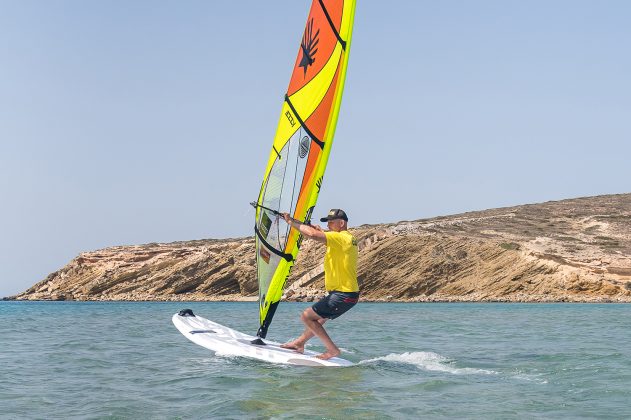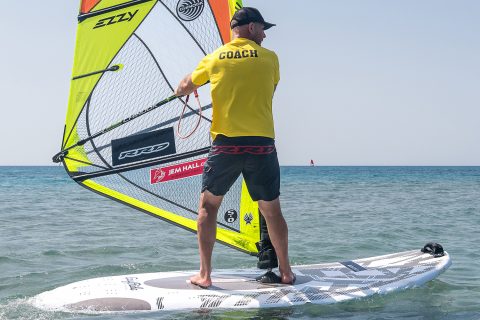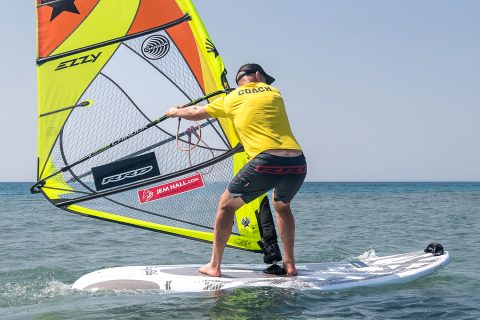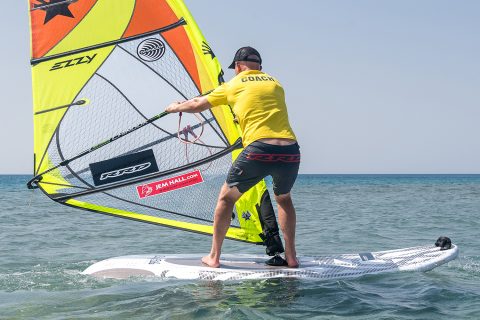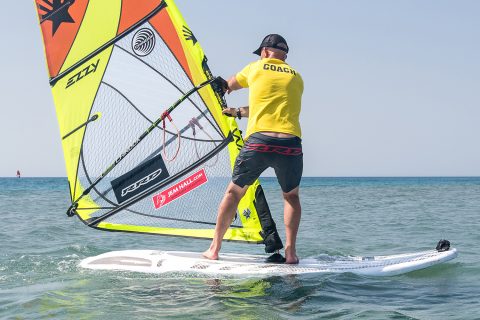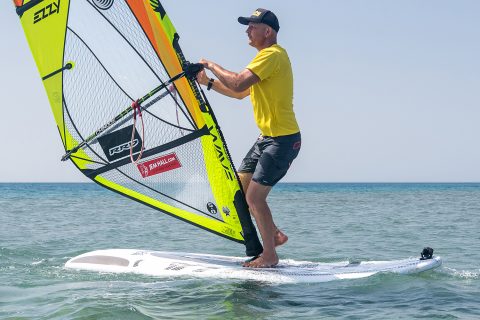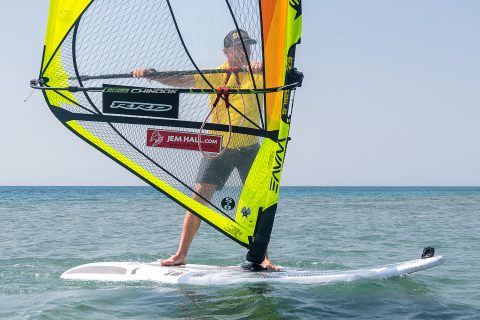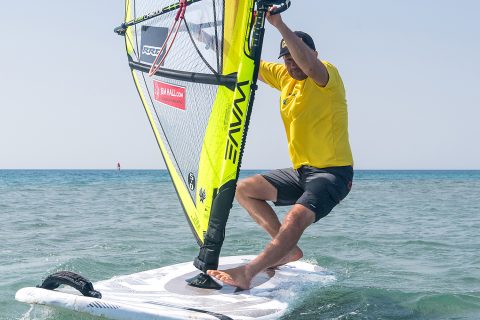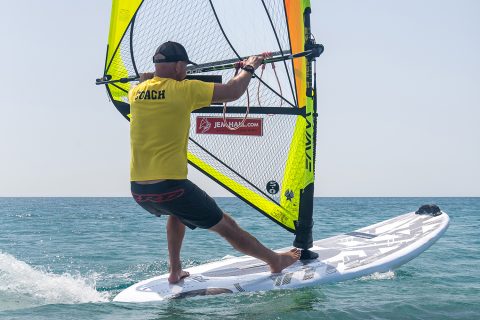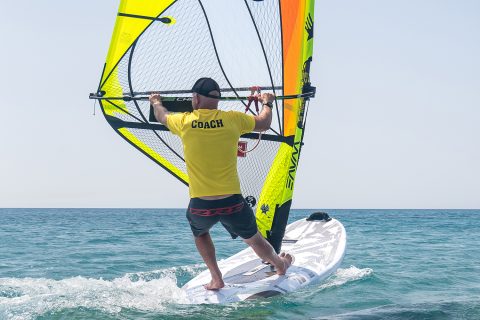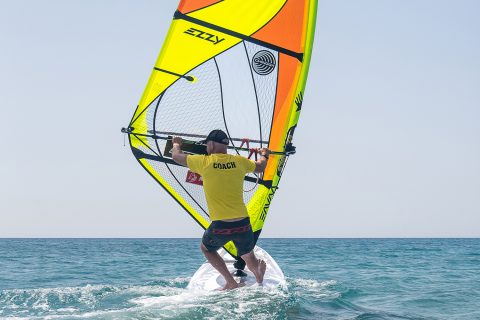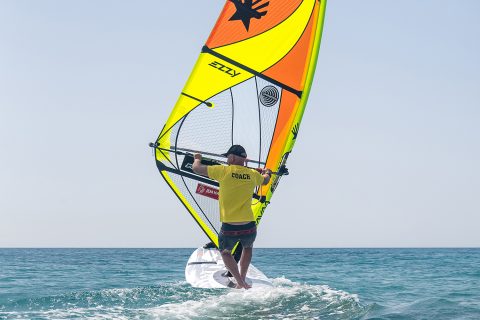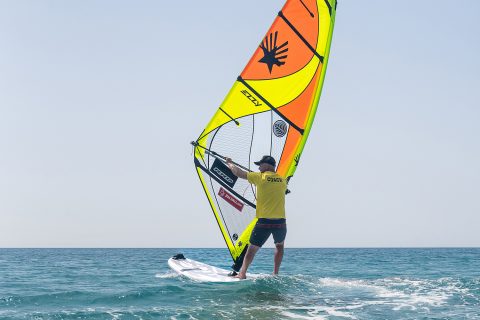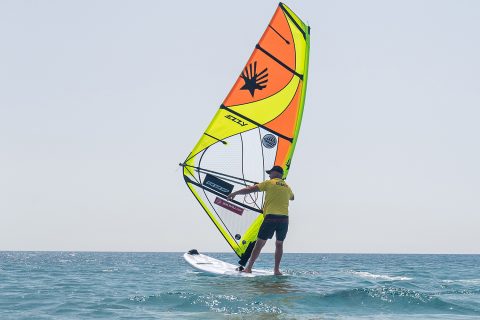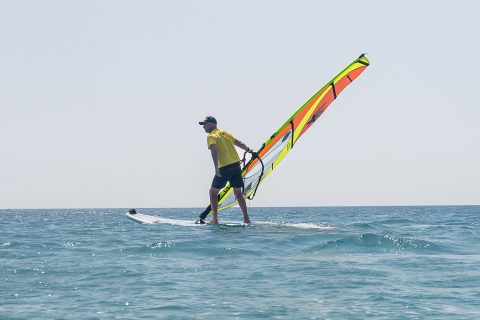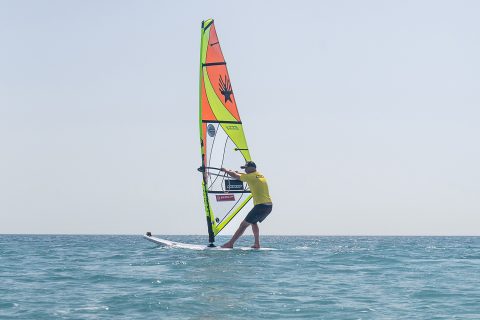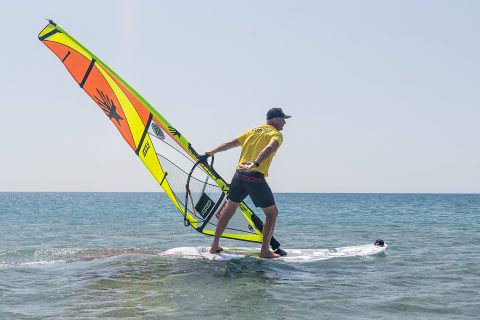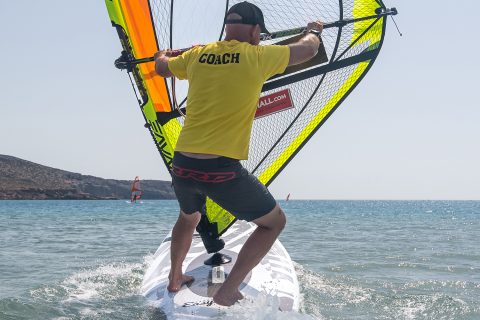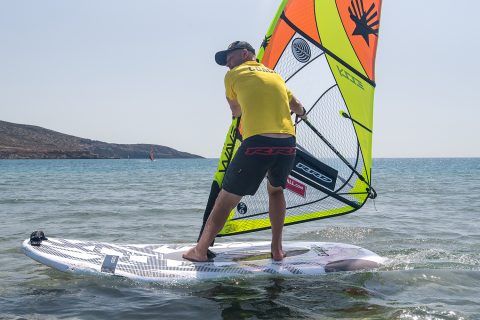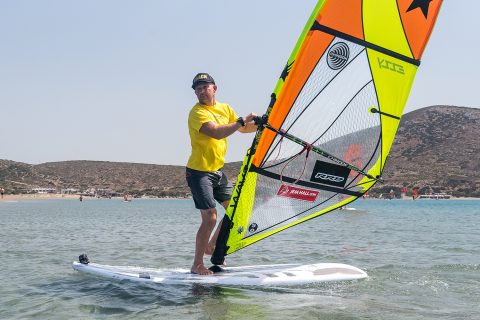JEM HALL
MOVE ON UP – WINDSURFING TECHNIQUE
LIGHT WIND TRANSITIONS
JEM HALL: LIGHT WIND TRANSITIONS
Jem Hall gives tips for light wind tacks and gybes.
PHOTOS – Eye Sea You Photo
I have learnt so much from coaching on my clinics and it is during light wind sessions that I really witness some of the biggest improvements from my people, and this progression then in turn transfers to their carving turns. It is just so much easier to gain confidence, add precision and feel incremental developments, when transitions can be done at slower speeds, with less stress, and on bigger boards. Getting out in lighter winds is for all levels, from beginner to winner.
I often say to my wavesailors that how we gybe is how we ride, to get them focused on their basics. I then go on to say that how we tack is how we gybe, in that we should be employing key actions that will really help us in both the tack and the gybe.
These key actions are:
- Scissoring: this is the pushing and pulling action of the legs – like pulling the nose towards the wind in a tack with your front foot, or pulling the tail upwind when bearing away into a gybe.
- Vision: where we look is where we go, but it is more than this. Looking in a certain direction moves our hips towards this, which then in turn weights the correct foot, so the other foot is ready to move. Key examples are looking forward into the tack and looking out of the turn mid-gybe.
- Getting space: this is also called counter balancing, where you are moving in the opposite direction to the rig. Think rig back on tack entrance, and thereby hips forward. Or rig out mid-gybe, and hips can then go into the turn.
- Precision: getting your hands and feet in the right place in the ‘prep’ phase of a turn will lead you to slicker foot transitions in the mid phase. Think back hand back and back foot back in the gybe.
Working on your moves in light winds on a big board will help you to employ and then develop all of the above, so you reap the rewards in windy sessions.
- Set up across the wind. Place your front hand on the mast, or at the front of the boom, and put your foot on the mastfoot.
- Rake the rig back as you look forward, shifting your hips both forwards and out. Scissor mainly with the front leg pulling.
- Just before head to wind, shift your vision to see the new side of the boom. Most of your weight is now on your front leg.
- Release the old back hand and reach around to the new side of the boom so you are ready to pivot and then steer efficiently in your exit.
- Old back foot toes place right next to the front foot’s heel and then you can move your new back foot down the board. Begin to look forward early in this phase, more than I am here.
- Looking forward will get rig forward and stepping back will put you in a strong ‘ready to scissor’ position. Your new front foot should have done an extra pivot to get it upwind of the mast foot and towards the rail. Note both hands are well down the boom.
- Drop and push. Get out and down and scissor those legs hard with the rig moving forwards and across you. Your tack exit is your gybe entrance, so exaggerate it and ail it.
Top tack tips
- Prepare early: get yourself set across the wind, this being front hand forward and then front foot forward.
- Pull rather than push: turn the board towards the wind by mainly pulling with the front foot, not by pushing hard on the back foot. This helps get the hips forward, and the front foot weighted.
- Use your head: really look forward into the tack, then see the new side of the boom and then aggressively turn the head to look forward for your exit. This is very very effective, and it is why tacking boosts all your moves!
- Dance: the footwork is a pivot, not a stumble, nor a hop, so get those feet moving and take off the concrete boots.
Top gybe tips
- Back, back, back: moving your front hand back, helps get your back hand back. Getting your back foot back will help you scissor / steer the board and resist power from the rig, on entrance and in the clew first exit.
- Push and pull: as you push the rig forwards really push through the front foot, whilst pulling the tail upwind with the back foot. This will get you off the wind and downwind, so you can do your foot change.
- See and send: mid gybe look out of the turn and see the clew as you send the rig to the outside of the turn, which then means you can get your hips to the inside for a sweet foot change.
- Push it: the back foot should not only be back, but also across, as there it can be pushed down to semi carve the board downwind, and yes ‘sending’ that rig really helps here too.
- Clew first: after your foot change you have to ‘take’ the clew first contact. Connect to it, control it, stay there and sail on a broad reach for a few board lengths.
- Slide and send: your clew first control and belief will give you ‘time to slide’ your front hand ALL the way to the front of the boom, which then makes the rig rotation way smoother. You can then send the rig back and shift your hips forward to counter balance this. Performing this action will also finish the turn and give you a bit of time to get your hand change right.
- Under and over: reach under your old front hand to grab the boom on the new side with an overhand grip and then throw that rig forwards hard to get some power to hang off.
- Set up across the wind with your hands back, and back foot way back. Turn downwind by getting the rig forwards and across you, whilst your legs scissor hard, front foot pushing and back foot really pulling. Being back and out puts you in a strong position.
- Keep scissoring and begin to shift the rig to the outside of the gybe and move your hips to the inside by seeing the clew. Remember to ‘push it’ on the rail with the back foot.
- At dead downwind feel most of your weight on your back foot as you pull down on the boom and really bend your back leg. This makes you ready for the foot change.
- Old back foot toes place right next to the front foot’s heel and then you can move your new back foot down the board. Begin to look forward early in this phase, more than I am here.
- Let the sail open up and take some power clew first. Think rig forwards and body back and out and sail off the wind for a board length in this position.
- Slide the mast hand all the way towards the mast, release the back hand and actively guide the rig back as you keep looking forwards with your body outboards, mast upright.
- Look forward and send the rig back as you then reach under your front hand to grab the boom on the new side.
- With your new front hand on the boom, send the rig forward hard so your hands can slip down the boom into a strong position. Be ready for the power by getting down and out.
Drills to build skills
- Hand slides: sail across the wind and slide your back hand up and down the boom to really feel how far back it can and should go and to get accustomed to it. Slide your front hand all the way forward so it is ready to be there for a tack, or rotate the rig in the gybe exit.
- Leg lift: sail along across the wind and lift up your front foot. This will make you bend your back leg, and pull down on your arms, which are both crucial actions in windsurfing.
- Aggressive scissoring: turn the board up and downwind and really feel how much to use the rig, scissor your feet and counterbalance with your hips. And move your back hand for turning downwind. You will also realise how using your ‘vision’ really assists here.
- Sail duck to rotate: duck the sail and hold it clew first and then rotate it. This will boost your clew first skills (along with clew first beachstarts) and improve sliding your mast hand for slick rig rotation.
- Sending the rig back and you forwards and out after rotating the rig gives you time and helps to finish the gybe.
Common mistakes
- Turning too early: turning the board upwind for a tack, before getting your hand and foot forward, will see you rushing to catch up.
- Foot position: having your front foot too far forward in a tack and then moving your back foot too far in front of it, will see you sinking the nose. Get the front foot on the mastfoot and the other foot very close to it in transition.
- Feet before hands: moving the feet before moving your hand to the new side will mean a stumbled exit. Release (old back hand), reach (to new side of boom) and then pivot your feet to move them slickly.
- Not back enough: if your hands and feet are not back enough in the gybe, you cannot steer and be balanced, so the board won’t even start turning.
- Gear gazing: staring at the sail mid gybe will see your hips not move enough, so your feet will feel heavy and then you can’t move them mid gybe. Instead, look out of your turn!
- Clew fail: if you fail to take the power at the clew first exit phase, you are missing a huge point in the gybe. Do your due diligence please and own clew first sailing.
- Looks good? The hands are back and the body is low, however I am gear gazing and don’t have my back foot on the rail to ‘push it’. Get the rig out and hips across as you see the clew.
- My rig is back, and hands and feet are well positioned, however I need to get my hips way more forward and out, in order to get the rig even further back.
- Get hands on the new side of the boom and then look forward early as you are switching your feet.
Kit
Use balanced ‘floaty’ boards for light wind love, like a big freemove, beginner board or a windsurfing sup.
On a beginner board, move your mast foot forward so you can get it upwind and ensure it does not ‘over turn’.
Do not go too big on the beginner board, I favour a 180-litre over a 230-litre. You can start big and then go down a size if this helps. This action will add precision.
Placing a smaller fin in a big freemove board will make it more ‘turny’; and easier to beach start. E.g. a 35 cm, rather than 45 cm in a 135-litre board.
You can also take the front straps off a freemove board to gain more space.
Windsurfing sups are amazing for light wind drills and skills, they go upwind and have plenty of space on the deck.
Ezzy sails, RRD (boards, wetsuits & softwear), Chinook & Black Project fins sponsor Jem Hall. Get him live and direct on one of his highly acclaimed coaching holidays – check out his website www.jemhall.com for details. You can also follow him on twitter / Facebook / Instagram.


